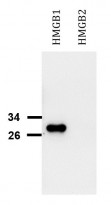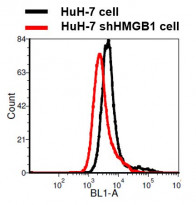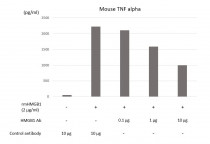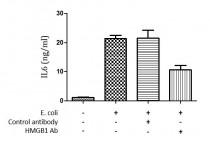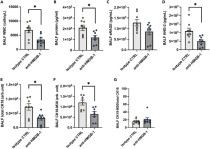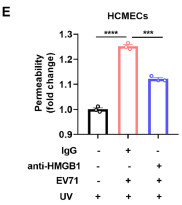ARG66714
anti-HMGB1 Neutralizing antibody [SQab20175] (low endotoxin)
anti-HMGB1 Neutralizing antibody [SQab20175] (low endotoxin) for ELISA,Flow cytometry,Neutralizing,Western blot and Bovine,Human,Mouse

Overview
| Product Description | Low endotoxin Mouse Monoclonal antibody [SQab20175] recognizes HMGB1. |
|---|---|
| Tested Reactivity | Hu, Ms, Bov |
| Tested Application | ELISA, FACS, Neut, WB |
| Specificity | This antibody could specifically neutralize HMGB1 induced pathway but not HMGB2 tested by TNF alpha releasing assay. |
| Host | Mouse |
| Clonality | Monoclonal |
| Clone | SQab20175 |
| Isotype | IgM, kappa |
| Target Name | HMGB1 |
| Antigen Species | Human |
| Immunogen | Human HMGB1. |
| Conjugation | Un-conjugated |
| Alternate Names | HMG-1; High mobility group protein B1; High mobility group protein 1; HMG1; SBP-1; HMG3 |
Application Instructions
| Application Suggestion |
|
||||||||||
|---|---|---|---|---|---|---|---|---|---|---|---|
| Application Note | Neutralizing assay: ARG66714 anti-HMGB1 Neutralizing antibody [SQab20175] suppresses HMGB1 induced TNF alpha releasing in both THP1 and Raw264.7 cell model. Please refer the data at below. * The dilutions indicate recommended starting dilutions and the optimal dilutions or concentrations should be determined by the scientist. |
||||||||||
| Observed Size | ~ 28 kDa |
Properties
| Form | Liquid |
|---|---|
| Purification | Affinity purification with immunogen. |
| Purification Note | Endotoxin level is < 0.1 EU/µg of the protein, as determined by the LAL test. |
| Buffer | PBS (pH 7.4) |
| Concentration | 0.5 mg/ml |
| Storage Instruction | Unopened antibody can be store at 2-8°C for up to a year. Once opened, for continuous use, store undiluted antibody at 2-8°C for up to one month; for long-term storage, aliquot and store at -20°C. This antibody should be freeze-thaw for only twice to avoid aggregation. Storage in frost free freezers and avoid repeated freeze/thaw cycles is recommended. Suggest spin the vial prior to opening. The antibody solution should be gently mixed before use. |
| Note | For laboratory research only, not for drug, diagnostic or other use. |
Bioinformation
| Database Links | |
|---|---|
| Gene Symbol | HMGB1 |
| Gene Full Name | high mobility group box 1 |
| Background | HMGB1 is a protein that belongs to the High Mobility Group-box superfamily. The encoded non-histone, nuclear DNA-binding protein regulates transcription, and is involved in organization of DNA. This protein plays a role in several cellular processes, including inflammation, cell differentiation and tumor cell migration. Multiple pseudogenes of this gene have been identified. Alternative splicing results in multiple transcript variants that encode the same protein. [provided by RefSeq, Sep 2015] |
| Function | HMGB1 is a DNA binding protein. It associates with chromatin and has the ability to bend DNA. Binds preferentially single-stranded DNA. Involved in V(D)J recombination by acting as a cofactor of the RAG complex. Acts by stimulating cleavage and RAG protein binding at the 23 bp spacer of conserved recombination signal sequences (RSS). [UniProt] |
| Highlight | Related products: HMGB1 antibodies; HMGB1 ELISA Kits; HMGB1 Duos / Panels; HMGB1 recombinant proteins; Anti-Mouse IgM secondary antibodies; Related news: HMGB1, a biomarker and therapeutic target in COVID-19 Total solution for HMGB1 research HMGB1 in inflammation Inflammatory Cytokines HMGB1 ELISA Kit for your research Detecting the DAMPs in cancer therapy by HMGB1 ELISA kit New HMGB1 neutralizing antibody is released Detecting exosomal HMGB1 for ICD research Inducing M2 polarization, a surprising function of HMGB1 Related poster download: HMGB2 Pathway.pdf |
| Calculated MW | 25 kDa |
| PTM | Phosphorylated at serine residues. Phosphorylation in both NLS regions is required for cytoplasmic translocation followed by secretion (PubMed:17114460). Acetylated on multiple sites upon stimulation with LPS (PubMed:22801494). Acetylation on lysine residues in the nuclear localization signals (NLS 1 and NLS 2) leads to cytoplasmic localization and subsequent secretion (By similarity). Acetylation on Lys-3 results in preferential binding to DNA ends and impairs DNA bending activity (By similarity). Reduction/oxidation of cysteine residues Cys-23, Cys-45 and Cys-106 and a possible intramolecular disulfide bond involving Cys-23 and Cys-45 give rise to different redox forms with specific functional activities in various cellular compartments: 1- fully reduced HMGB1 (HMGB1C23hC45hC106h), 2- disulfide HMGB1 (HMGB1C23-C45C106h) and 3- sulfonyl HMGB1 (HMGB1C23soC45soC106so). Poly-ADP-ribosylated by PARP1 when secreted following stimulation with LPS (By similarity). In vitro cleavage by CASP1 is liberating a HMG box 1-containing peptide which may mediate immunogenic activity; the peptide antagonizes apoptosis-induced immune tolerance (PubMed:24474694). |
Images (8) Click the Picture to Zoom In
-
ARG66714 anti-HMGB1 Neutralizing antibody [SQab20175] (low endotoxin) WB image
Western blot: 100 ng of HMGB1 and HMGB2 recombinant proteins stained with ARG66714 anti-HMGB1 Neutralizing antibody [SQab20175] (low endotoxin).
-
ARG66714 anti-HMGB1 Neutralizing antibody [SQab20175] (low endotoxin) ELISA image
ELISA: 2 µg/ml dilution of recombinant human HMGB1, bovine HMGB1 and recombinant human HMGB2 proteins (left to right) were coated onto ELISA plate. ARG66714 anti-HMGB1 Neutralizing antibody [SQab20175] (low endotoxin) at 1:3500 dilution were used for detecting HMGB1.
-
ARG66714 anti-HMGB1 Neutralizing antibody [SQab20175] (low endotoxin) FACS image
Flow Cytometry: HuH-7 cells (black) and HuH-7 shHMGB1 cells (red) stained with ARG66714 anti-HMGB1 Neutralizing antibody [SQab20175] (low endotoxin) at 1:500 dilution.
-
ARG66714 anti-HMGB1 Neutralizing antibody [SQab20175] (low endotoxin) neutralization image
Neutralization assay: Cell culture medium from THP1 cells treated with 10 µg of isotype control mouse IgM, plus 2µg/ml of rhHMGB1 or not as control. THP1 cells treated with 2µg/ml of rhHMGB1 plus 0.1 µg, 1 µg or 10 µg of ARG66714 anti-HMGB1 Neutralizing antibody [SQab20175] (low endotoxin) (left to right) as assay groups. TNF alpha concentration was tested by ARG80120 Human TNF alpha ELISA Kit.
-
ARG66714 anti-HMGB1 Neutralizing antibody [SQab20175] (low endotoxin) neutralization image
Neutralization assay: Cell culture medium from Raw264.7 cells treated with 10 µg of isotype control mouse IgM, plus 2 µg/ml of rhHMGB1 or not as control. Raw264.7 cells treated with 2 µg/ml of rmHMGB1 plus 0.1 µg, 1 µg or 10 µg of ARG66714 anti-HMGB1 Neutralizing antibody [SQab20175] (low endotoxin) (left to right) as assay groups. TNF alpha concentration was tested by ARG80206 Mouse TNF alpha ELISA Kit.
-
ARG66714 anti-HMGB1 Neutralizing antibody [SQab20175] (low endotoxin) neutralization image
Neutralization assay: Mouse were injected with E. coli (3 x 10^9 CFU/kg) intraperitoneally. After 3 hours, antibodies (15 mg/kg) were given by i.p. injection. Mouse sera were collected 24 hours later and examined the level of IL6.
-
ARG66714 anti-HMGB1 Neutralizing antibody [SQab20175] (low endotoxin) neutralization image
Neutralization assay: Mouse treat with ARG66714 anti-HMGB1 Neutralizing antibody [SQab20175] (low endotoxin) or ARG66747 Mouse IgM Kappa Isotype Control antibody.
From Kentaro Tojo et al. iScience (2023), doi: 10.1016/j.isci.2022.105748, Fig. 6.
-
ARG66714 anti-HMGB1 Neutralizing antibody [SQab20175] (low endotoxin) neutralization image
Neutralization assay: HCMEC in the presence of ARG66714 anti-HMGB1 Neutralizing antibody [SQab20175] (low endotoxin) or ARG65345 Mouse IgG Isotype Control antibody.
From Qiao You et al. Virus Res (2023), doi: 10.1016/j.virusres.2023.199240, Fig. 4E.
Customer's Feedback
 Excellent
Excellent
Review for anti-HMGB1 Neutralizing antibody [SQab20175] (low endotoxin)
Application:Others
Experiment:Neutralization assay: Raw264.7 cells were treated with HMGB1 and antibody for 10 minutes then added into wells. After 24 hours, supernatants were collect and examined the level of TNF alpha.
Specific References
